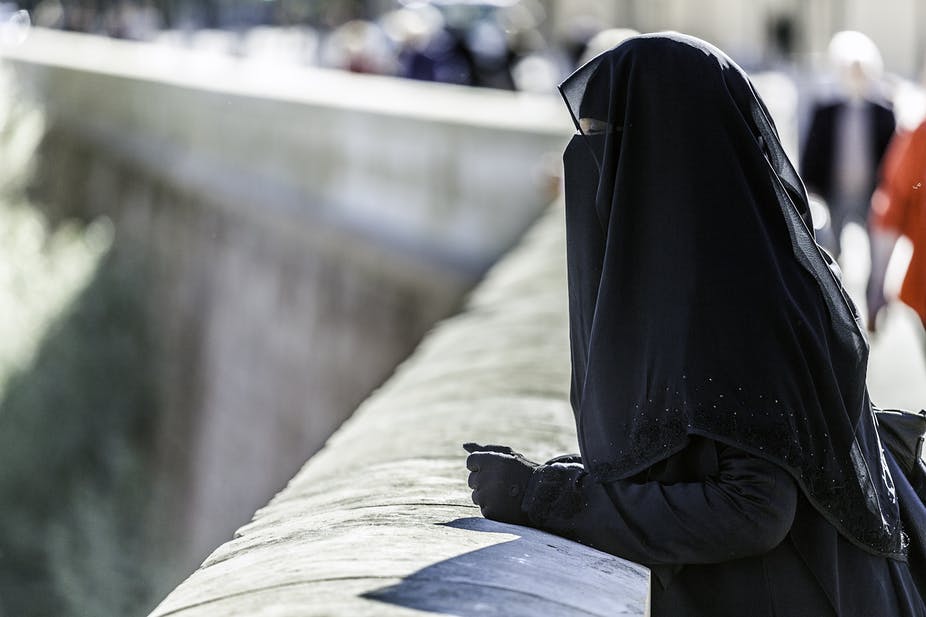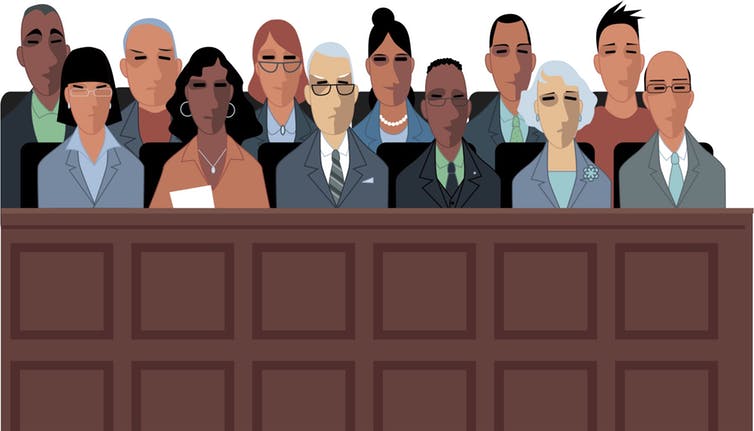Women should be allowed to wear the niqab in court – here’s why
Jeremy
Robson, The Conversation, March 9, 2018
The
debate about whether a woman who wears the niqab should be allowed to do so
when giving evidence in court is one which polarises opinion.
debate about whether a woman who wears the niqab should be allowed to do so
when giving evidence in court is one which polarises opinion.

The niqab is the
full face veil worn by a small number of Muslim women. Unlike many other
countries, the United Kingdom has not sought to criminalise the
wearing of full face veils and many consider it to be a legitimate expression
of religious belief protected by the European Convention on Human Rights.
full face veil worn by a small number of Muslim women. Unlike many other
countries, the United Kingdom has not sought to criminalise the
wearing of full face veils and many consider it to be a legitimate expression
of religious belief protected by the European Convention on Human Rights.
But there
remains a tension between respecting the rights of a minority to manifest their
religion and the needs of the courts to ensure trials are conducted fairly. New guidance
issued to judges in reminds them of the need to consider carefully whether or
not a witness should be asked to remove her veil when giving evidence. But does
it strike the right balance?
remains a tension between respecting the rights of a minority to manifest their
religion and the needs of the courts to ensure trials are conducted fairly. New guidance
issued to judges in reminds them of the need to consider carefully whether or
not a witness should be asked to remove her veil when giving evidence. But does
it strike the right balance?
The
number of niqabis in England and Wales (the jurisdiction to which the guidance
applies) is unknown, but they represent small proportion of the population –
and cases where a judge is required to make a ruling involving the niqab are
rare. When these cases do arise they are subject to enormous public scrutiny.
In 2013, the judge Peter Murphy made headlines when he ruled
that a defendant in a criminal trial could wear her niqab for the duration of
her trial but if she wanted to give evidence in her defence she had to remove
it. Many praised
the judge’s pragmatic approach to the situation, but others were concerned that
it represented a disproportionate intrusion into how a person could dress.
number of niqabis in England and Wales (the jurisdiction to which the guidance
applies) is unknown, but they represent small proportion of the population –
and cases where a judge is required to make a ruling involving the niqab are
rare. When these cases do arise they are subject to enormous public scrutiny.
In 2013, the judge Peter Murphy made headlines when he ruled
that a defendant in a criminal trial could wear her niqab for the duration of
her trial but if she wanted to give evidence in her defence she had to remove
it. Many praised
the judge’s pragmatic approach to the situation, but others were concerned that
it represented a disproportionate intrusion into how a person could dress.
Objection!
The most common
objection to the wearing of the niqab is that it prevents the
fact-finder seeing the witness’s face and detecting changes in demeanour that
might be a clue that the witness is lying. Without this, it is argued,
there is a risk that a jury might fail to realise that a witness is lying or
has something to hide and reach the wrong decision. The harm caused by this
would outweigh any harm caused by interfering with an individual’s right to
manifest her religion.
objection to the wearing of the niqab is that it prevents the
fact-finder seeing the witness’s face and detecting changes in demeanour that
might be a clue that the witness is lying. Without this, it is argued,
there is a risk that a jury might fail to realise that a witness is lying or
has something to hide and reach the wrong decision. The harm caused by this
would outweigh any harm caused by interfering with an individual’s right to
manifest her religion.
 |
| How much does a person’s demeanour actually influence a jury? Aleutie/Shutterstock.com |
My research indicates that
the approach taken by judges all over the world is to assume that the veil will
hamper the assessment of credibility and order its removal to ensure a fair
trial. While this argument seems compelling, it is based on flawed assumptions.
It has been established that people are generally very poor at using demeanour
to assess credibility – indeed, recent research has
established that assessments of credibility are more reliable when the witness
has their face covered. And if there is no evidence to support to prove wearing
the veil does impact upon the trial process, then there is no basis to order
its removal.
the approach taken by judges all over the world is to assume that the veil will
hamper the assessment of credibility and order its removal to ensure a fair
trial. While this argument seems compelling, it is based on flawed assumptions.
It has been established that people are generally very poor at using demeanour
to assess credibility – indeed, recent research has
established that assessments of credibility are more reliable when the witness
has their face covered. And if there is no evidence to support to prove wearing
the veil does impact upon the trial process, then there is no basis to order
its removal.
Many would
argue that there is little harm in requiring a witness to remove her
veil and that as the veil is a sign of male subjugation and should not be
protected. But this is too broad an approach to a complex issue. Many women
choose to cover their face as a matter of choice to achieve a state of piety.
The wearing of the niqab is a visible representation of this and being required
to remove it represents an invasion with their deeply held beliefs.
argue that there is little harm in requiring a witness to remove her
veil and that as the veil is a sign of male subjugation and should not be
protected. But this is too broad an approach to a complex issue. Many women
choose to cover their face as a matter of choice to achieve a state of piety.
The wearing of the niqab is a visible representation of this and being required
to remove it represents an invasion with their deeply held beliefs.
Seen but
not heard?
not heard?
Unlike
many other public spaces (such as schools), courts often offer individuals no
control over how people engage with them. Someone who wishes to seek the
protection of the law often has no choice but to proceed through the courts. If
a victim of a criminal offence wants the protection of the police, they make
their complaint knowing that ultimately they may be required to give evidence
in court.
many other public spaces (such as schools), courts often offer individuals no
control over how people engage with them. Someone who wishes to seek the
protection of the law often has no choice but to proceed through the courts. If
a victim of a criminal offence wants the protection of the police, they make
their complaint knowing that ultimately they may be required to give evidence
in court.
In this
context, the worrying rise
in hate crime towards Muslims since 2016 is relevant. Many of the
victims of these attacks have been singled out because of their clothing. Women
who wear the niqab have been particularly
vulnerable to such attacks, with attackers often seeking to
humiliate them by removing the niqab. For the victim of such an attack, the
prospect of having to further compromise their beliefs by removing their veil
in court can only add to their sense of persecution. This may discourage them
from seeking help at all.
context, the worrying rise
in hate crime towards Muslims since 2016 is relevant. Many of the
victims of these attacks have been singled out because of their clothing. Women
who wear the niqab have been particularly
vulnerable to such attacks, with attackers often seeking to
humiliate them by removing the niqab. For the victim of such an attack, the
prospect of having to further compromise their beliefs by removing their veil
in court can only add to their sense of persecution. This may discourage them
from seeking help at all.
Despite
the importance of this issue, there is no guidance in legislation or from the
appeal courts. The latest edition
of the Equal Treatment Bench Book reminds judges to only require removal of the
veil where they consider it to be “essential” and reminds judges hearing
non-criminal cases of the fallibility of evaluation of credibility from
demeanour. But judges in criminal trials are told that not removing the veil
might impair the court’s (so the jury’s) ability to evaluate reliability.
the importance of this issue, there is no guidance in legislation or from the
appeal courts. The latest edition
of the Equal Treatment Bench Book reminds judges to only require removal of the
veil where they consider it to be “essential” and reminds judges hearing
non-criminal cases of the fallibility of evaluation of credibility from
demeanour. But judges in criminal trials are told that not removing the veil
might impair the court’s (so the jury’s) ability to evaluate reliability.
Although
the language of the guidance provides some clarity, and stresses the need for
sensitivity, it still suggests that juries benefit from seeing witness’s face
when there is no basis for doing so and implies that where it is the defendant
who wishes to wear the veil they should remove it to give evidence. There may
be always be exceptional cases which justify the removal of the veil and judges
should have the power to order this, but it is not enough to do so on the basis
of what the jury may or may not think.
the language of the guidance provides some clarity, and stresses the need for
sensitivity, it still suggests that juries benefit from seeing witness’s face
when there is no basis for doing so and implies that where it is the defendant
who wishes to wear the veil they should remove it to give evidence. There may
be always be exceptional cases which justify the removal of the veil and judges
should have the power to order this, but it is not enough to do so on the basis
of what the jury may or may not think.
A better
course of action would be to permit the wearing of the niqab where it has been
requested and to direct the jury that it makes no difference to their
assessment of the evidence. For a justice system to truly represent all of
society it must ensure that the most marginalised groups are able to access it
without having to compromise their beliefs unless it is absolutely necessary.
course of action would be to permit the wearing of the niqab where it has been
requested and to direct the jury that it makes no difference to their
assessment of the evidence. For a justice system to truly represent all of
society it must ensure that the most marginalised groups are able to access it
without having to compromise their beliefs unless it is absolutely necessary.


